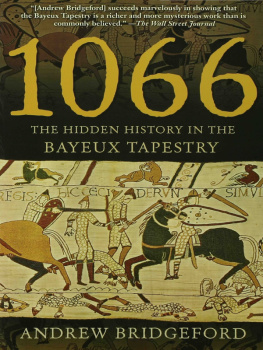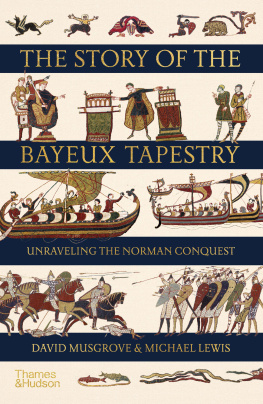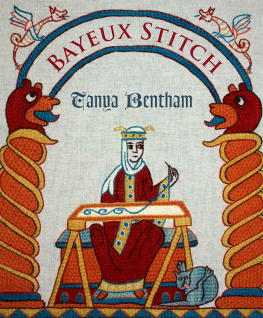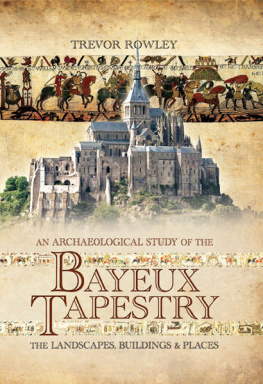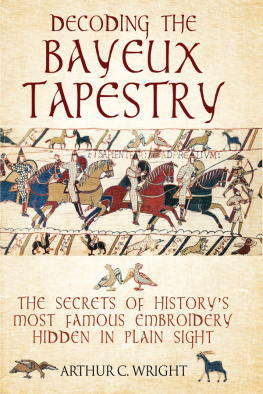Andrew Bridgeford - 1066: The Hidden History in the Bayeux Tapestry
Here you can read online Andrew Bridgeford - 1066: The Hidden History in the Bayeux Tapestry full text of the book (entire story) in english for free. Download pdf and epub, get meaning, cover and reviews about this ebook. year: 2006, publisher: Walker & Company, genre: Religion. Description of the work, (preface) as well as reviews are available. Best literature library LitArk.com created for fans of good reading and offers a wide selection of genres:
Romance novel
Science fiction
Adventure
Detective
Science
History
Home and family
Prose
Art
Politics
Computer
Non-fiction
Religion
Business
Children
Humor
Choose a favorite category and find really read worthwhile books. Enjoy immersion in the world of imagination, feel the emotions of the characters or learn something new for yourself, make an fascinating discovery.
- Book:1066: The Hidden History in the Bayeux Tapestry
- Author:
- Publisher:Walker & Company
- Genre:
- Year:2006
- Rating:4 / 5
- Favourites:Add to favourites
- Your mark:
- 80
- 1
- 2
- 3
- 4
- 5
1066: The Hidden History in the Bayeux Tapestry: summary, description and annotation
We offer to read an annotation, description, summary or preface (depends on what the author of the book "1066: The Hidden History in the Bayeux Tapestry" wrote himself). If you haven't found the necessary information about the book — write in the comments, we will try to find it.
1066: The Hidden History in the Bayeux Tapestry — read online for free the complete book (whole text) full work
Below is the text of the book, divided by pages. System saving the place of the last page read, allows you to conveniently read the book "1066: The Hidden History in the Bayeux Tapestry" online for free, without having to search again every time where you left off. Put a bookmark, and you can go to the page where you finished reading at any time.
Font size:
Interval:
Bookmark:
10
ANDREW BRIDGEFORD
The Hidden History in the
Bayeux Tapestry

Copyright 2004 by Andrew Bridgeford
All rights reserved. No part of this book may be used or reproduced in any manner whatsoever without written permission from the publisher except in the case of brief quotations embodied in critical articles or reviews. For information address Walker & Company, 104 Fifth Avenue, New York, New York 10011.
Reproductions of the Bayeux Tapestry by
special authorization of Bayeux Town
Published in 2006 by Walker Publishing Company Inc.
Distributed to the trade by Holtzbrinck Publishers
All papers used by Walker & Company are natural, recyclable products made from wood grown in well-managed forests. The manufacturing processes conform to the environmental regulations of the country of origin.
The Library of Congress has cataloged the hardback edition of
this book under LCCN: 2004381071
eISBN: 978-0-802-71940-9
Originally published in Great Britain in 2004 by Fourth Estate First published in the United States in 2005 by Walker & Company This paperback edition published by Walker & Company in 2006
Visit Walker & Company's Web site at www.walkerbooks.com
Printed in the United States of America by Quebecor World Fairfield
4 6 8 10 9 7 5 3
Eventually
All things decline
Everything falters, dies and ends
Towers cave in, walls collapse
Roses wither, horses stumble
Cloth grows old, men expire
Iron rusts and timber rots away
Nothing made by hand will last
I understand the truth
That all must die, both clerk and lay
And the fame of men now dead
Will quickly be forgotten
Unless the clerk takes up his pen
And brings their deeds to life again
Wace, Roman de Rou, III, ll. 131-142
(c. 1170)
Contents
References to scene numbers in the book refer to scenes in the first plate section. References to plates correspond to images in the second plate section.
Five miles from the coast at Arromanches, in the gently shelving valley of the River Aure, lies the historic Norman town of Bayeux. From a distance the medieval cathedral emerges first into view, a faint impression of towers and spires, which gradually falls into sharper perspective as you approach the fringes of the town. War has touched Bayeux, but not scarred it. A ring road circumscribes the old centre, like a protective wall, and within its confines lies a network of shadowy streets and old stone buildings; and here and there the late-medieval frontage of a half-timbered house protrudes into the sunlight, as if it had emerged unwittingly out of the past into the present. At the centre of the town rises the enormous cathedral, a Gothic masterpiece built upon a Romanesque shell, its stark western towers, completed in the days of William the Conqueror, still soaring above the family of little houses gathered closely around its base. But it is not the cathedral, remarkable as it is, that every year draws half a million visitors to Bayeux. They come to see one of the most famous, intricate and mysterious works of art that has ever been made. Signs directing you to this masterpiece are dotted around the centre of the town. They are marked with a single descriptive word, in French and in English: 'Tapisserie.Tapestry'. Here, in Bayeux, anything else would be redundant.
The route marked 'Tapestry' takes you along these narrow streets, under the eves of ancient houses and beneath the angular shadows of the cathedral. It passes by shops selling every item that can possibly be embossed with images of the Bayeux Tapestry, from mugs to mouse pads, tea towels to T-shirts. You may pause to recall the conquering exploits of Duke William of Normandy under the pale green awning of the Restaurant Le Guillaume or remember his wife, Queen Matilda, at the Hotel de la Reine Mathilde. Not far away a crepe may be consumed at the somewhat more alarmingly branded Creperie Le Domesday. The journey takes you past these establishments and along the Rue de Nesmond until you reach a sizeable seventeenth-century building that was turned into a museum in the early 1980s. During the course of its long and dangerous history, the Bayeux Tapestry has been kept, and sometimes concealed, in several places in and around the town of Bayeux. This building is its modern home. Your eyes narrow at the museum's gate. Rain puddles scattered around the courtyard reflect the sun's fresh glare like so many broken panes of glass. A party of English schoolchildren has gathered in front of the door, a posse of noisy chatter, scuffed heels and clipboard assignments gripped with an innocent disregard. Two hundred yards away, Bayeux Cathedral is a silent witness to your journey, a stone silhouette imposed on a bright and changing sky.
You open the museum door, blinking as you enter. Inside it is quiet. You must buy a ticket. You follow a broad flight of stairs and then you emerge into a series of introductory rooms, like antechambers taking you step by step into the inner sanctum of a medieval mystery. At length you arrive in the longest of all the rooms, a long, windowless, narrow corridor with an unexpected bend in the middle. It is here that the Bayeux Tapestry is displayed, carefully illuminated in the darkness behind a thick glass case. It is stretched out in front of you like an enormous strip of film, a great colourful frieze of the Middle Ages, bright and lively, receding narrower and narrower into a dim and uncertain distance. Although barely half a metre wide, the work is astonishingly long, incredibly long for something that is so old and that ought to be so fragile that if you picked it up it might collapse into shreds. It runs for as far as can be seen along the wall of this narrow gallery, and then it rounds a bend and continues for as long again. It is, in total, about seventy metres in length; and it would have been perhaps ten metres longer had the final scenes not been lost at some distant point in the past. Even as it is, the surviving tapestry would outstretch Nelson's Column by more than a third of its height.
The dramatic story of the Norman invasion of England in 1066 is set out in these threads, stitched by contemporaries and preserved and displayed here, in the very heart of victorious Normandy. Despite its great age and fragility, the work is uniquely well preserved. Most of what we see today is entirely original, and in those places where it has been repaired, the marks left by the original stitches seem, with certain exceptions, to have been followed with care, and such restorations as have been made to the tapestry do not generally interfere with the thrust of its interpretation. Embroidered on to a plain linen background in wools of red, yellow, grey, two greens and three shades of blue, the tapestry remains, against all expectation, as bright and captivating as if it had been made yesterday rather than nearly a thousand years ago. As you step along the dimly lit gallery, the extraordinary story unfolds. The linen stage fills up quickly with busy figures, in castles and halls, on ships and on horseback, urgently looking here, pointing there, full of meaning, their voices straining through the centuries to tell us something secret and important. This is a medieval tale of intrigue, danger and war. It begins with the mysterious events that occurred a year or two before 1066 - the crucial background to what followed before building to a climax with the events that made 1066 the most decisive year in English history. Amidst all the high drama, everyday details, recorded incidentally and without pretension by the artist, vividly bring his world to life: here some men are feasting on spitted birds; there they are drinking wine from ivory horns; others hunt, sow or go to church; men wade through the shallow water with their tunics hitched high or struggle, bent forward, to load heavy provisions on to a waiting ship. Each time you look, it seems that some further beguiling detail, previously missed, becomes apparent. The work is at once accessible and straightforward and yet at the same time deeply mysterious and arcane. A Latin commentary running along the top of the main frieze by turns illuminates and then infuriates us by its very terseness and ambiguity. Above and below the main frieze, two narrow borders are filled with strange designs: creatures, real and mythical, ancient fables drawn from Classical authors, astrological symbols, scenes of everyday life, the odd erotic incident.
Font size:
Interval:
Bookmark:
Similar books «1066: The Hidden History in the Bayeux Tapestry»
Look at similar books to 1066: The Hidden History in the Bayeux Tapestry. We have selected literature similar in name and meaning in the hope of providing readers with more options to find new, interesting, not yet read works.
Discussion, reviews of the book 1066: The Hidden History in the Bayeux Tapestry and just readers' own opinions. Leave your comments, write what you think about the work, its meaning or the main characters. Specify what exactly you liked and what you didn't like, and why you think so.

